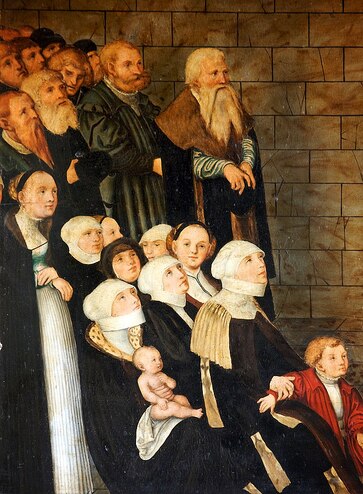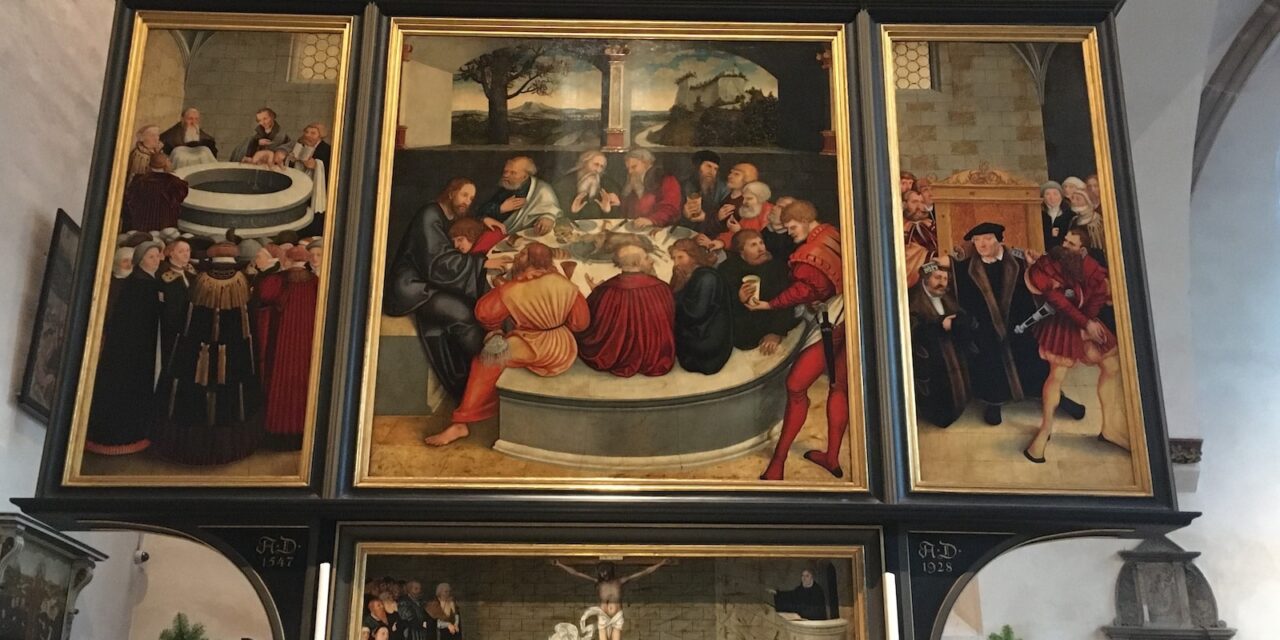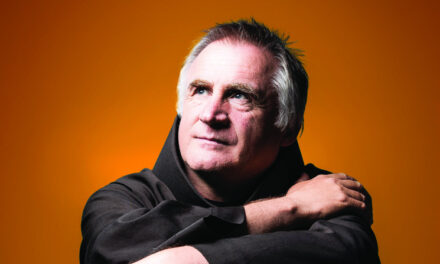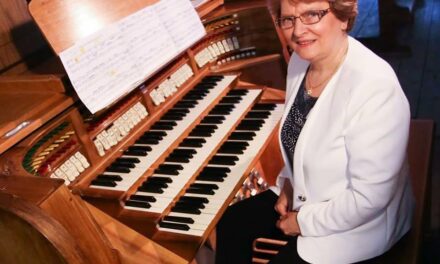Along with our weekly spiritual journeys
Not only books, but also paintings, sculptures, and even all kinds of fine arts have their own history. Art history is based on this. We hear and talk less about the fact that each work has its own message. Many also have a spiritual message. We can also call these preaching paintings. They are not about themselves, but about what the artist created them for. Europe is very rich in preaching images. Let's just listen to the testimony of the very eloquent pictures, despite their silence. First of all, the message of the completely Protestant painting, which is very unique in the history of painting, and truly reforming, which we owe to the elder Lucas Cranach (1472-1553), can be seen as an altarpiece in the Wittenberg city church. It dates from 1547. The master completed it one year after the death of the reformer Márton Luther. A pictorial obituary and memoir at the same time...
Painter of the Reformation - Preacher with a brush
Lucas Cranach the Elder was a respected and famous citizen of Reformation-era Wittenberg. Painter, printer, pharmacist, and for some time even mayor of the Luther town, as a contemporary of the reformer. He was not only the publisher of Luther's Bible, but also an illustrator. He even helped Katharine von Bora on her way to becoming a reformer, as a blessing of which she accepted the difficult fate of being a reformer as a wife and partner with Luther, who took on thousands of spiritual and spiritual struggles and life-threatening situations.
In the paintings of Cranach, the painter of the Reformation, the symbolic message constantly coexists with reality.
The central large picture above of the entire altarpiece depicts the Last Supper with Jesus, Luther and citizens of Wittenberg sitting in the place of the former disciples. The painting on the left shows a large baptismal font with Philip Melanchthon, the educator of Germany, baptizing a baby as a layman. The painting on the right wing of the altar shows the pastor of the church, Luther's successor, Johannes Bugenhagen, exercising the power of the keys: forgiving and absolving the half-kneeling sinner on his right and sending away his accuser.
The most important part of the entire composition, the basis, rock, carrier, and foundation of everything is the crucified Christ and the reformer preaching about him. The axis of the church and the world, even the axis of the cosmos, is with the Crucified Lord. A visionary, virtual, silent sermon about the essential insights of the Reformation: Christ alone, solus Christus, is the axis of existence of everything, the foundation of new life. This Christ is the alpha and omega of preaching, the church community, the Lord's Supper, baptism, absolution and forgiveness in the spiritual and real sense. Also for community rehabilitation after personal repentance and confession.
There are those who put it this way about this group of altarpieces: the essence of the Protestant, Reformation doctrine of the sacrament and doctrine of the Church, soteriology, and the doctrine of salvation is condensed into a pictorial message in Cranach's altarpiece. In contrast to the Roman Catholic altarpieces of the time, the Virgin Mary is nowhere to be seen here, but the contemporaries who, looking to Christ, started and launched the reformation, renewal of faith, and even the renewal of not only the church, but the city, and even the world of the time, and set it on a path that shaped world history.
The human figures in the pictures - citizens of Wittenberg in period clothing, soldiers, pastors, theologians, church members, women and a young mother holding a baby in her lap, perhaps waiting for baptism - do not live their faith with their eyes fixed on the sky, but on Christ, the axis of the church square and the world square, with an extremely attentive look fixed on the Crucified One, the God-Man. Almost absorbing the sight, what they saw and especially what they heard. After all, faith comes from hearing, and hearing through the word of Christ (Romans 10:17). These people experience that the Kingdom of God is among them. It does not float somewhere above their heads, but is present in the community that half of them observe. This church is a community of love. It has cohesion because it has a center, the living Christ. St. Exupéry wrote in one place in his diary: those who really love each other look in the same direction. Not only lovers, but also religious people. As members of one, many, millions of church communities that have been, are alive today, and will be alive in the future.
Your personal eye contact with the congregation - Our life is in the embracing arms of God
We can observe very important Protestant congregational characteristics, especially in the independent image of Christ, which forms the basis of the entire altarpiece structure. Luther, an unforgettable preacher for the city and the congregation, is depicted in the pulpit by the painting giant, who surely respects him from the heart, with the open Bible on the pulpit's rim, Luther's left hand resting on it. And his right hand swings forward, his fingers clearly pointing at the Crucified Lord. He does not look at the Bible or notes while preaching, but at the congregation itself.

(Photo of the painting: Gene Edward Veith)
He seeks the audience's gaze. Eat one at a time. Makes eye contact. Something special and holy circulation takes place during his preaching: he leans on the Word with his left hand, the hand on the side of the heart, and his heart, drawing from it the life-giving message as if from a living source. The Word permeates his whole personality. He gives his heart to the message, the Messenger. Sola Scriptura, Scripture alone is the source of all salvation. This is also depicted in the Cranach composition. Luther's gaze is not directed directly at the One, but at the church members. Even the face of the Crucified One turns towards the congregation.
As if he were saying: I leave everything to you, I give you what I suffered for, what I carried a cross for. Know that I have overcome the world with this cross. All other claims are false and misleading, the tricks of the great Liar, the Scammer. I conquered the world in front of you, for you, for you, in which you are still struggling, looking for the only and sure support. Here I am: I am the way, the truth and the life (John 14,6). Brilliant composition. A great sermon - true through the ages!
And something else. An invisible circle of heavenly-earthly embrace emerges before our examining eyes, which also depicts the meaning of the earthly service of the mother-holy-church. Namely: Luther's hand on the Bible, his outstretched arm pointing to Christ, and the shepherd, spiritual caretaker, life counselor who keeps an eye on the people, the real, living church, and looks after them, almost embraces the living Christ in the hearts of the church members. He, Who is no longer the one who looks at the community from this picturesque Cranach cross, since this cross is not really present in the church square. But the Christ who was taken down from the cross, resurrected on the third day, defeated the world and will remain with us until the end of the world is present. What a huge, heart-shepherding, eternal and limitless community is the Mother Church, for which He gave His life and, as the Risen One, carries us today as a living Lord, He is with us, embraces us, nourishes us spiritually and physically, He takes care of us.
This living, eternal community is also indicated by his preaching painting by the great elder Cranach, whose pulpit became the altarpiece in Wittenberg with many messages. Protestant, with its symbolic and real messages. Blessed be God, who invented and used such sights and painting pulpits to proclaim His Word, for the benefit of our lives. In the digital world, very realistically. Because we have a real, living, not virtual Christ!
Author: Dr. Lajos Békefy
Cover photo: Lucas Cranach's winged altar in the Stadtkirche in Wittenberg (Photo: Gene Edward Veith)













